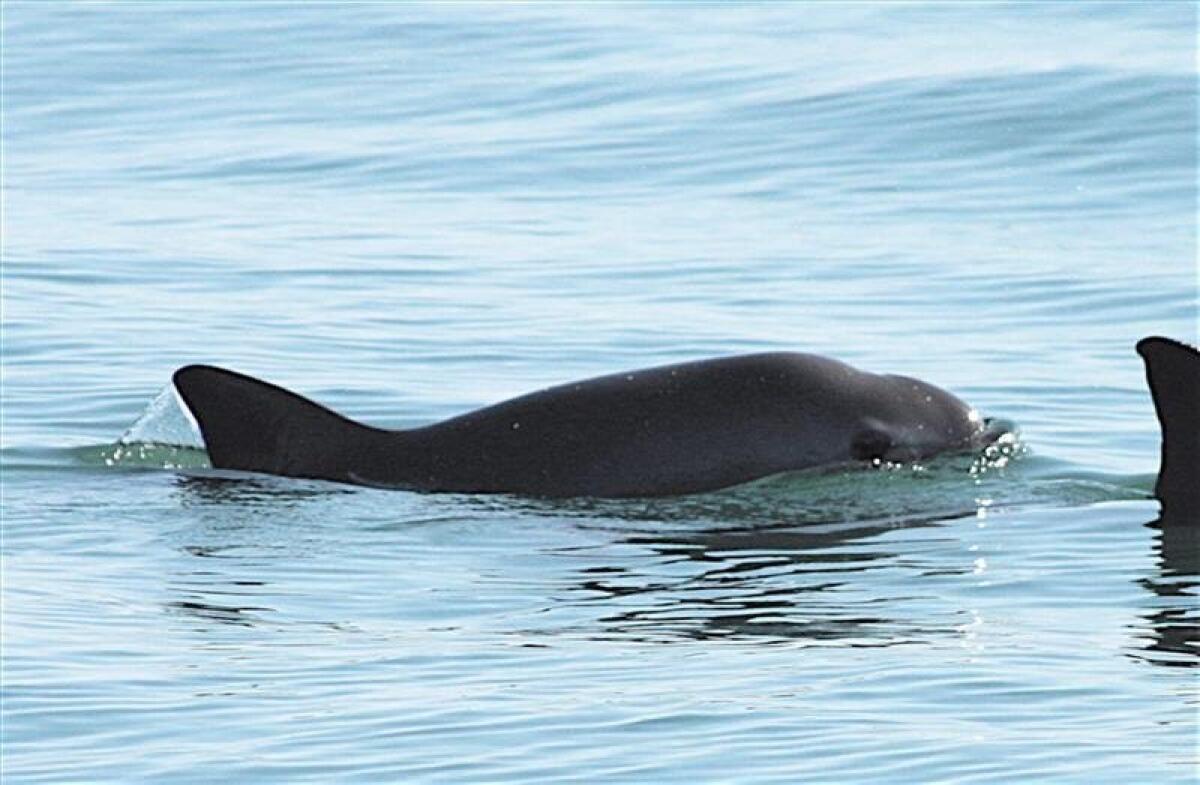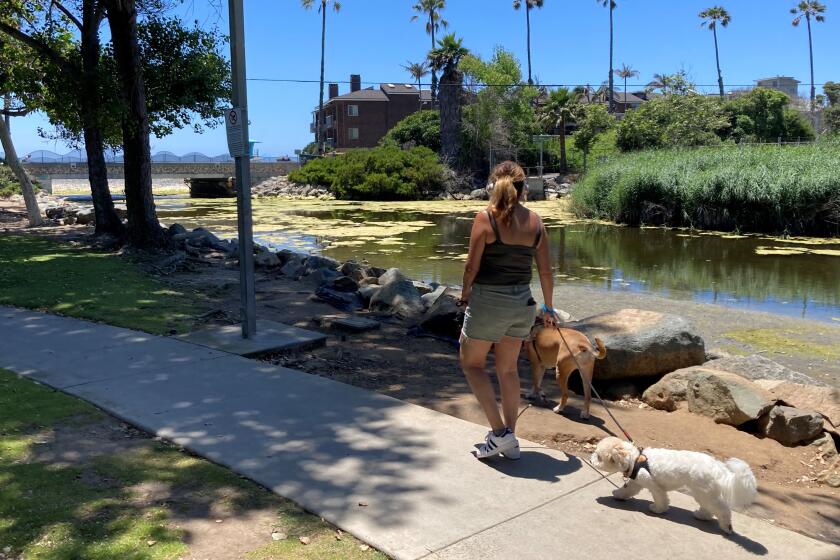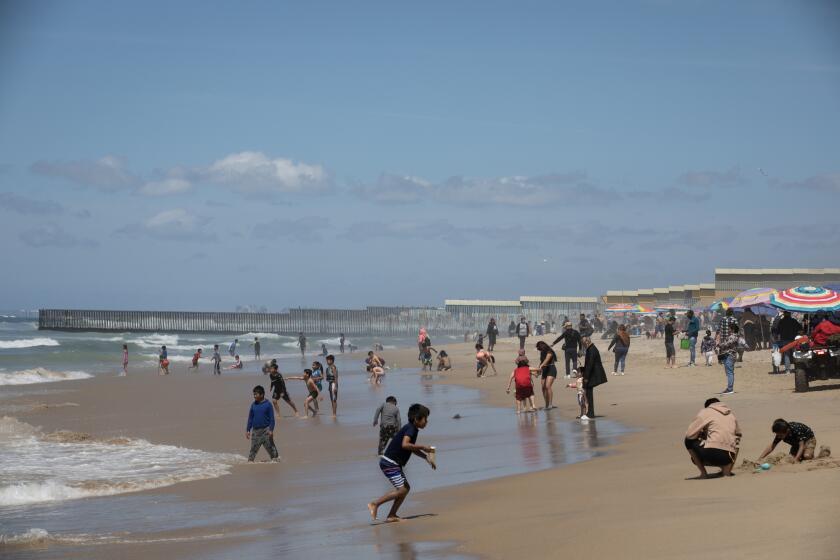In search of Mexico’s vanishing vaquita
Researchers scour Gulf of California: ‘They are there, but they’re rare’

It lasted no more than a couple of seconds: Two dark, finned figures simultaneously leaped from the water then disappeared. A mile away, aboard the research vessel Ocean Starr, scientists barely contained their excitement as they peered through their giant “big eye” binoculars.
These were vaquita marina, a small porpoise endemic to the upper Gulf of California that is on the brink of extinction. Fewer than 100 are now believed alive. The team of expert observers, most of them from the United States and Mexico, recorded the sighting some 25 miles northeast of San Felipe, and continued scouring the water’s calm surface for more.
An unprecedented effort this year by Mexico’s federal government aimed at preserving the species has spurred this exhaustive $3 million survey off the Baja California peninsula. On this warm autumn afternoon, the panorama was all sky and water — save for the occasional commercial trawler on the horizon and a rocky islet teeming with birds and sea lions at the heart of the vaquita refuge known Rocas Consag.
“We are finding what we expected to find,” said Barbara Taylor, a conservation biologist at the National Oceanic and Atmospheric Administration’s Southwest Fisheries Science Center in La Jolla, and the expedition’s U.S. chief scientist. “They are there, but they’re rare.”
The world’s smallest cetacean, vaquitas grow to four or five feet, weigh up to 120 pounds, and are characterized by dark rings around their eyes and dark patches on their lips, earning them the nickname “panda of the sea.” They live only in one place: the rich and turbid waters of Mexico’s Upper Gulf of California, and are very hard to detect, as they avoid boats, surface only briefly, barely splash, usually travel in groups of one or two.
Yet the species, first identified in the 1950s, has come under an unprecedented international spotlight, a subject of concern for both the U.S. and Mexican governments, and the focus of campaigns by environmental groups including the World Wildlife Fund, the Center for Biological Diversity and Greenpeace.
For the observers on board the 171-foot Ocean Starr, every sighting has been the subject of celebration — confirmation that vaquitas still survive.
“Your heart starts beating hard,” said Lorenzo Rojas-Bracho, Mexico’s chief scientist on the vaquita expedition and coordinator of research and marine mammal conservation at Mexico’s National Institute for Ecology and Climate Change. “But everybody stays calm and continues doing their work as professionals.”
Two-year gillnet ban
The vaquitas, which must surface to breathe, for years have become ensnared and drown in gillnets used by fishermen to catch fish and shrimp from small boats. The threat has been compounded by the illegal fishing, also with gillnets, of another endangered species, the totoaba fish, whose swim bladders are in high demand in China for their perceived medicinal properties.
In recent years, the extinction of another marine mammal, the baiji dolphin, from China’s Yangtze River has added urgency to calls to save the vaquita. The Mexican government has taken a number of steps, including the establishment of a vaquita refuge in 2005, but the vaquita population continued to fall.
View the Video Vaquita: On the brink of extinction
In April, Mexican President Enrique Peña Nieto took the unprecedented step of declaring a two-year gillnet ban in the vaquita habitat in the Upper Gulf, effectively putting out of commission hundreds of small boats, or pangas, that fish from the coastal towns of San Felipe and the Golfo de Santa Clara. While the ban lasts, nearly 2,700 fishermen and boat owners who made their living in the upper Gulf are being paid through a compensation program that is costing Mexico $36 million a year.
Along with the ban, Mexico has deployed its navy to the area, dramatically stepping up enforcement. Areas where fishermen openly flouted fishing regulations have now been cleared of boats.
“The vaquitas have no option, they cannot go anywhere else. The fishermen can look for other options,” said Rojas-Bracho, who is the co-chief scientist of the vaquita survey. “The whole thing is to have a sustainable fishery here, using other gear.”
But in San Felipe, many fishermen are counting the days until they can go back to sea with their gillnets.
Sipping coffee early one morning on San Felipe’s scenic malecon, Alfredo Lucero Rubio, known as El Pio, said he has not seen a vaquita since the 1960s. “It’s an animal that can’t even be eaten,” said Lucero, adding that “the government doesn’t know what it’s doing; the vaquita is going to go extinct anyway.”
Lucero argues that gillnets are not what have caused the vaquita’s population to plummet, and instead blames the dramatically diminished flow from the Colorado River into the Upper Gulf, which he says has reduced the vaquitas’ food supply. The theory has been espoused by others who oppose the gillnet ban, but disavowed by Rojas-Bracho and other scientists who note that all vaquitas seen are fat and healthy and show no signs of insufficient food.
By contrast, some San Felipe fishermen report very recent sightings. “The majority of people don’t want to admit that vaquita still exist,” said Jose Luis Romero, a longtime fisherman nicknamed Chalunga. “They hold the belief that if they deny its existence, then they can go back to gillnet fishing.”
Romero is among a small group of fishermen who since 2007 have collaborated closely with researchers and government agencies in the search for alternative fishing gear. They stand prepared to use an experimental vaquita-safe shrimp net but have not been issued permits by the Mexican government.
Unlike their fellow fishermen who continued using gillnets to catch shrimp, they are receiving no compensation, and they say they are in an economic bind. “They take away our opportunity to fish, but they don’t compensate us either,” Romero said. “We don’t understand what the government is doing with us.”
View the photo gallery: Expedition to help save endangered vaquita
Survey most rigorous to date
The scientists’ previous surveys show a rapidly declining population, from 567 vaquitas in 1997 to 245 in 2008. By 2014, the estimated the population had dropped to 97, with fewer than 25 reproductively mature females. The current survey, commissioned by Mexico’s Secretariat of the Environment and Natural Resources, began Sept. 26 and ends Dec. 3; it is the most rigorous to date.
“We knew it was going to be particularly challenging because the fewer animals there are, the harder it is to get a precise estimate,” Taylor said. “We knew it was going to be under a lot of scrutiny by a lot of people.”
Counting vaquitas is not an easy task — or even a possible one, as sightings could be repeats, and some vaquitas could be missed altogether. The survey estimates the density of vaquitas. By mid-November, scientists had more than 20 sightings, but the final results that fold together all the data collected to estimate the total vaquitas on earth won’t be available until May, after months of analysis by an international team of specialists.
The current study is an abundance survey that includes both visual and acoustic components. Aboard the Ocean Starr the observers use the 25-power binoculars to scan the water, working during daylight hours and when the conditions are calm enough to spot vaquitas. As the vessel moves through the water at six knots, the observers scan the surface, calling out the location of each sighting to a recorder, who immediately enters the data onto a computer. This allows the exact location to be seen on an interactive map.
“Dolphins will jump and splash at the surface,” said observer Jay Barlow, a longtime marine mammal researcher at the Southwest Fisheries Science Center. “But porpoises never do that. You just see the dorsal fin breaking on the surface.”
The survey also includes an acoustic component, through the placement of 134 CPODS, which register the high-frequency clicks used by the vaquita to locate prey.
In the meantime, the scientists are taking heart from the visits of a series of Mexican officials who were able to peer through the binoculars and for the first time spot vaquitas for themselves. Baja California’s governor, Francisco Vega de Lamadrid, and Mexico’s environmental minister, Rafael Pacchiano, are among those who have been able to see vaquita in recent weeks. “Having the minister and the dignitaries here changes the story of the vaquita,” Rojas-Bracho said.
It’s not just the Mexican government and conservation groups that are watching the survey’s results. U.S. government agencies are watching too. By August 2016, the United States expects to adopt new regulations aimed that forces foreign seafood producers to meet U.S. marine mammal protection standards, or lose their ability to export their product to the United States. The fishermen in the Upper Gulf, who sell a good portion of their shrimp catch to the United States, could be especially affected.
The lessons learned here could serve other parts of the world, said Nina Young, of NOAA’s international affairs office, who was aboard the Ocean Starr for several days this month.“This is not the only place where you have gillnets and marine mammals,” Young said. “We’ve got to develop mitigation measures that reduce marine mammal by-catch, otherwise we’re from place to place having this same problem.”
The vaquita, “is our marine mammal species, it’s the responsibility of Mexico and Mexicans to take care of it for the world,” Rojas-Bracho said. “We have to change the way we see the world, you have to have a more biocentric view. If you just save what has economic value, you’re going to lose everything.”
sandra.dibble@sduniontribune.com (619) 293-1716
Get Essential San Diego, weekday mornings
Get top headlines from the Union-Tribune in your inbox weekday mornings, including top news, local, sports, business, entertainment and opinion.
You may occasionally receive promotional content from the San Diego Union-Tribune.












